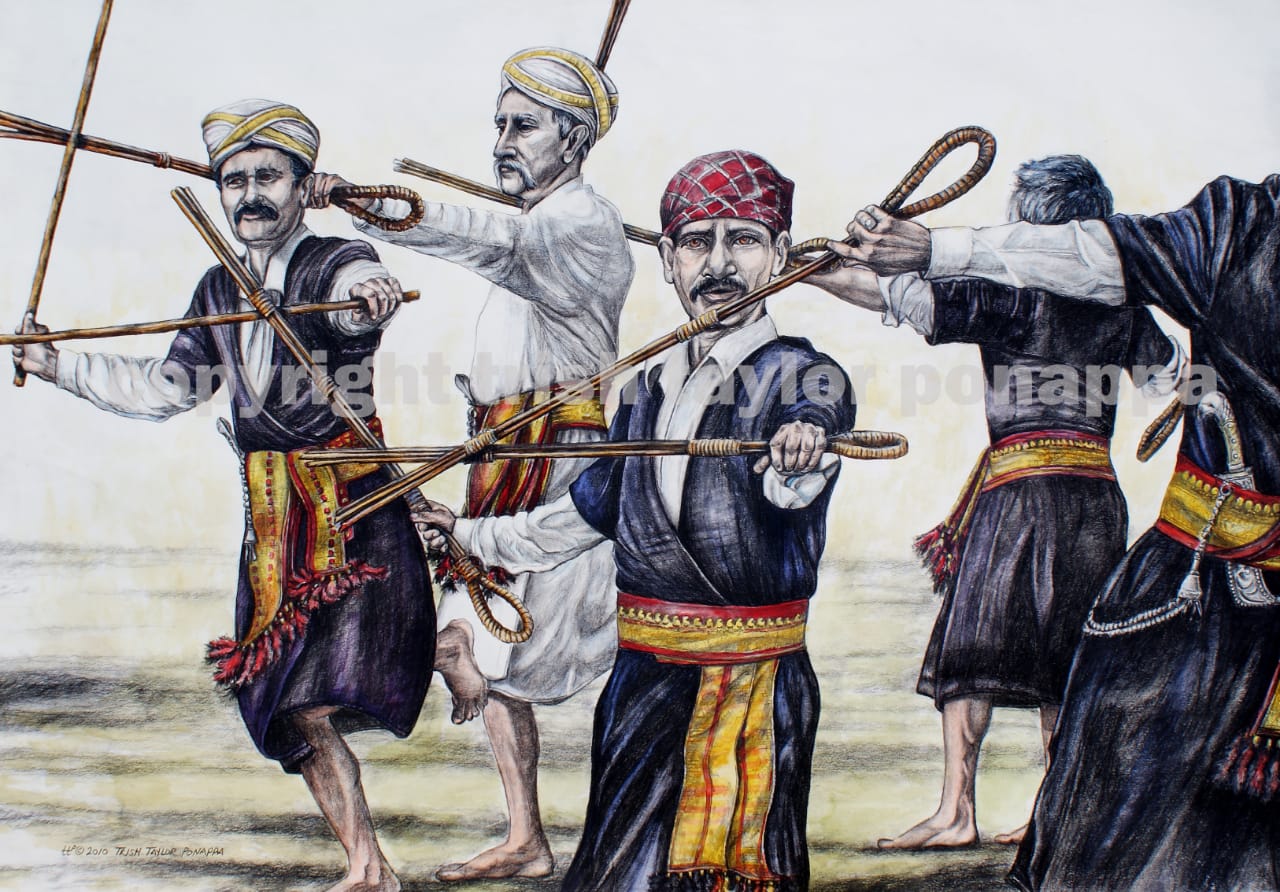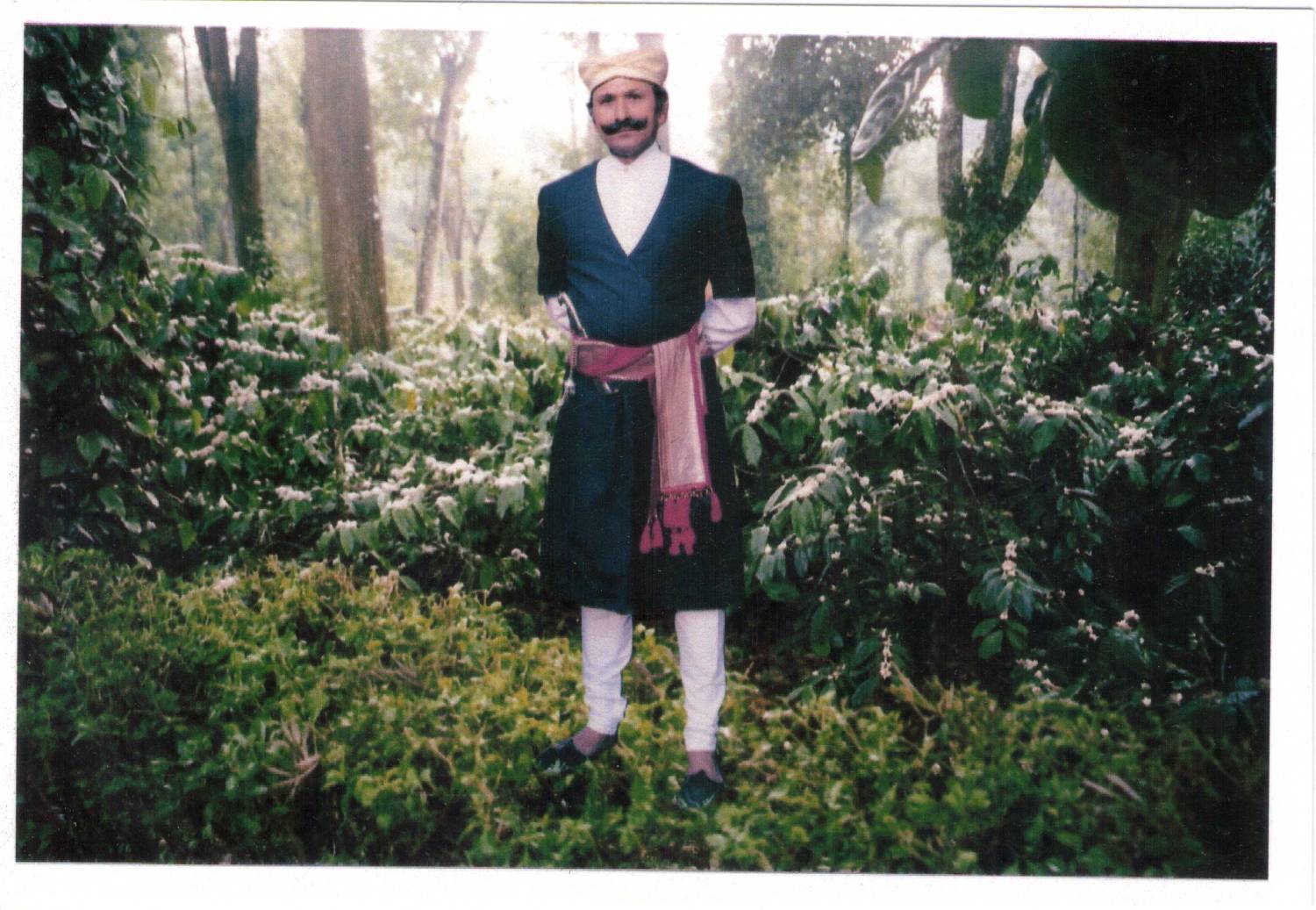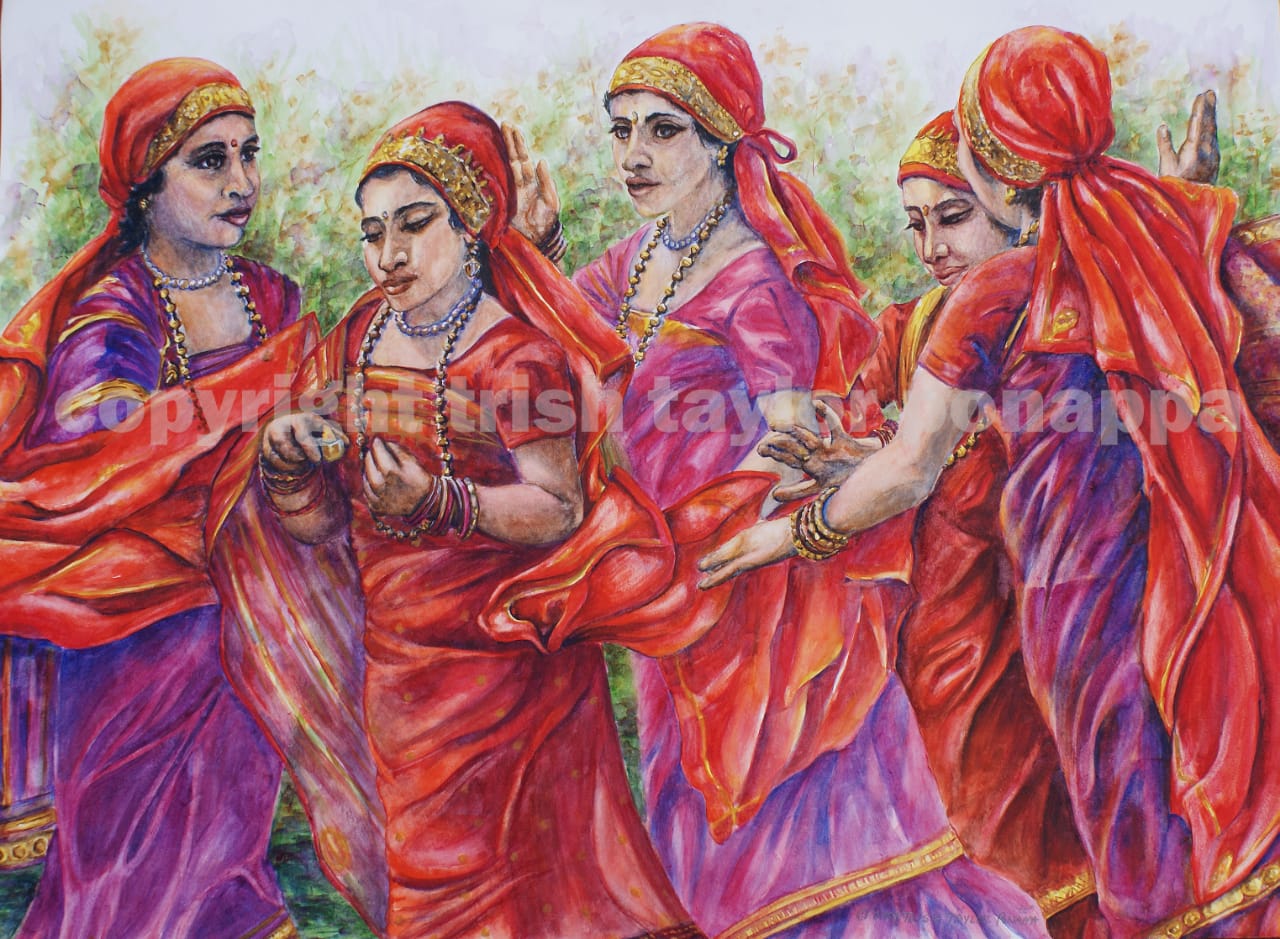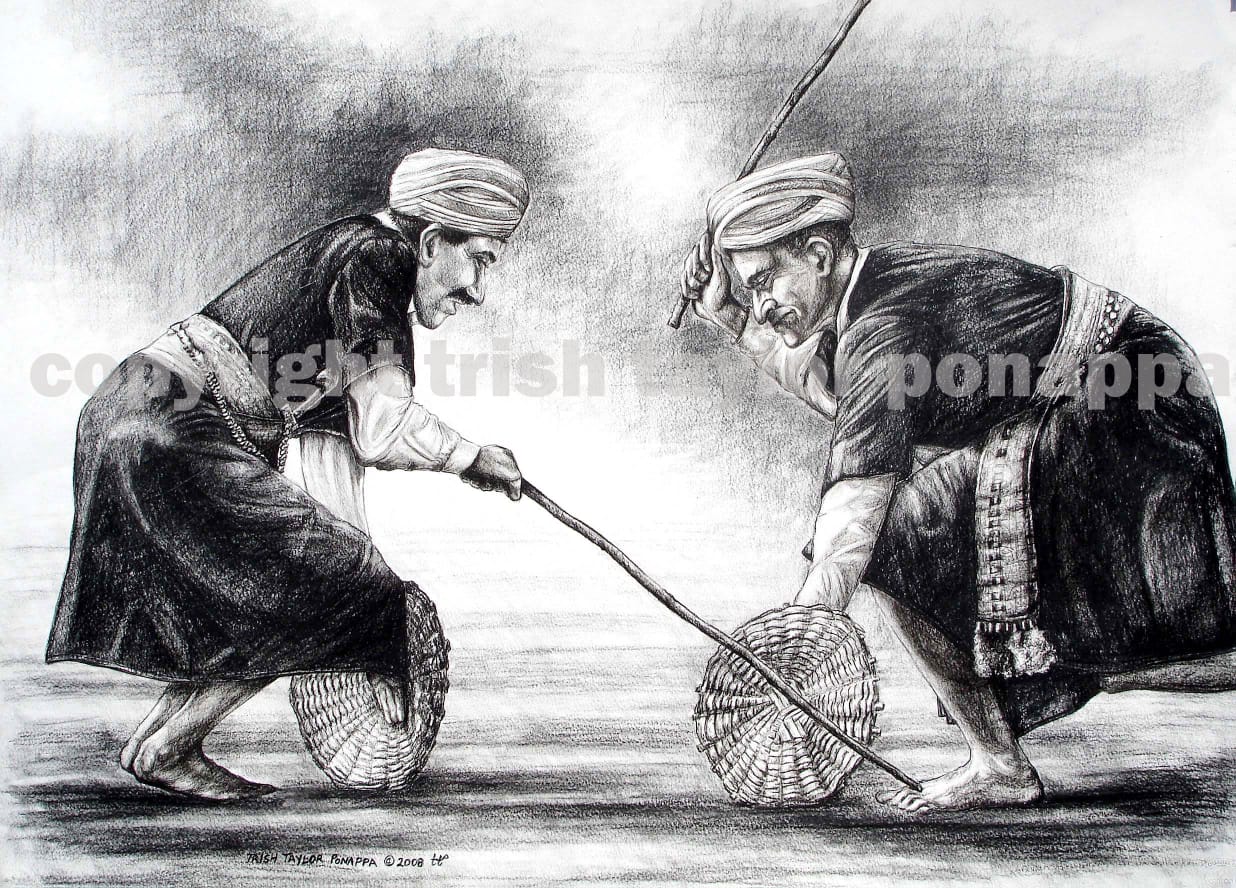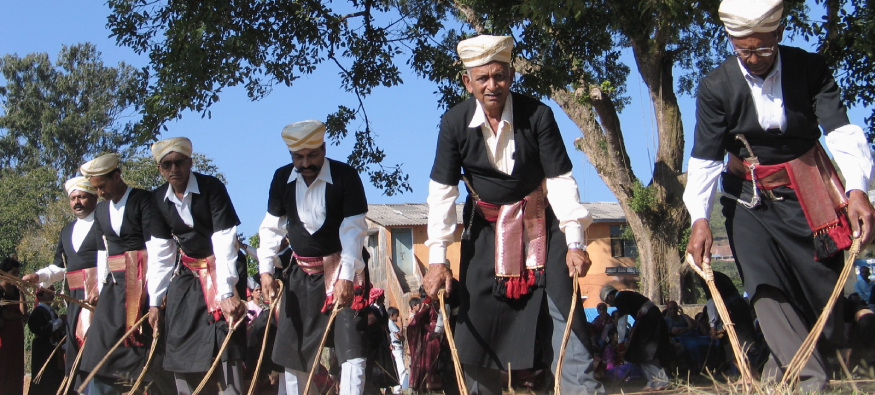
Kodavas
KNOW THE ROOTS
Kodagu (Coorg, as the British called it), the smallest district in Karnataka, is perched on the Western Ghats at a height of about 1000m above sea level. It is known for its breath-taking scenery – rugged hills, dense tropical forests once teeming with wild animals, lush coffee plantations on hill slopes, green rice fields in the valleys, winding streams and rivers, and cascading waterfalls. About a third of the district is covered by forests fed by monsoon rains that lash the region for nearly four months in the year. The river Kaveri (Cauvery), revered as their mother goddess by the people of Kodagu, takes birth in Kodagu.
There are references to Kodagu in Tamil literature of the Sangam period (2nd Century AD) and in Ganga, Chola and Hoysala inscriptions of the 12th century.
Over the centuries, chieftains owing allegiance to different dynasties ruled over parts of Kodagu. The Haleri Rajas of Kodagu, who were Lingayats by faith and spoke Kannada, were originally Ikkeri Nayakas. It was one of their princes who came to Haleri near Madikeri and cleverly took over Kodagu and gradually established himself as the ruler of Kodagu. His dynasty, called the Haleri or Lingayat Rajas ruled Kodagu from 1600 to 1834. When they were removed by the British, Kodagu (Coorg) was made a Chief Commissioner’s Province. The Indian Constitution recognized Coorg as Part ‘C’ State, entitled to have its own responsible government. In 1956, when the states were reorganized on a linguistic basis, Kodagu became part of Karnataka state.
Kodavas are among the earliest inhabitants of Kodagu. Very little is known about their origins or early history, and none of the many conjectures about their origins have been substantiated. They are an indigenous land-owning community of hunters and warriors, with strong ties to the land and a martial tradition.
Kodava Culture
Kodavas are a numerically small community with their population numbering about a lakh and a half world-wide. The district of Kodagu, which can be contained in a rectangle that is 100 km by 60 km, is a tiny part of India. The Kodava community is a minority community that has, since the first census in 1871, never been more than 20% of the population of Kodagu. But it is one of the largest communities in Kodagu, and since time immemorial has been a culturally dominant community, giving the district its distinct image.
Kodava cultural traditions and practices were transmitted orally from generation to generation. (It was only in 1924 that Nadikerianda Chinnappa compiled Kodava traditions and folksongs in the Pattole Palame book, which was acclaimed by the University of Mysore as the earliest extensive collection of the folklore of a community in an Indian language.) Yet, the Kodava community has retained its unique culture and maintained its identity and its distinctive way of life over many centuries. This is a culture that has survived despite the inevitable influences of the cultures of the neighbouring areas, despite being ruled by non-Kodavas until Independence (by the Lingayat kings and the British), despite the turbulent periods in its history, and in spite of the demands of modernity in today’s world. There have been inevitable changes, but these have not been significant enough to alter the culture substantially.
Some Unique Aspects of Kodava Culture
The first thing that strikes one as ‘different’ about Kodavas is their traditional dress. The Kodava woman drapes her sari in a distinctive style with the pleats tucked at the back of the waist and the pallu (loose end of the sari) drawn under her left shoulder and secured over the right – a very convenient style, with the hands free for agricultural and other work. On her head she wears a vastra (long veil) tied back at the nape of her neck.
https://youtu.be/qRu3Xph3Xl8?si=W_v7XxsiRNZSulcw
The traditional jewellery worn by Kodava women is also distinctive and is inspired by nature – the moon, flowers, fruits, snake etc. It commonly uses repousse work, where a small quantity of gold is beaten to paper thinness and moulded in the desired pattern, giving it a three-dimensional effect. The typical chains include the kokke thathi (long gold chain of hollow gold beads, with a large crescent-shaped pendant filled with lac, set with graduated rubies, with hanging pearls along its bottom edge, and with the hood of a cobra at its top); the pathak, symbol of a married woman (chain of gold and coral beads on a twisted strand of black glass beads, with a gold coin framed by rubies and surmounted by a cobra hood as a pendant); jomale (two long rows of grooved hollow gold beads filled with lac, strung on black cord). Adorning the Kodava woman’s wrists are the jodi kadaga (hinged bracelet with two hollow gold bands) and pounchi (two or three parallel rows of hollow gold flower buds strung tightly on an elastic black cord). Besides these, traditional jewellery for a bride includes finely crafted silver jewellery for her feet, with individual toe-rings each of a different design, linked with chains to an ornamental anklet. This constrains the bride’s steps and makes her walk slowly.
https://www.coorgtourisminfo.com/jewelleries/arati-monappa-on-coorg-jewellery/
The Kodava man’s attire is a kupya (long black or white wrap-around tunic) secured with a red gold-embroidered silk chele (sash), into the front of which is tucked a peeche kathi (dagger sheathed in an ornate scabbard of silver and gold, ivory and wood). A white mande thuni (turban) or a red chouka (checked scarf, much like the ones worn in the Middle East) is tied around his head. An odikathi (war knife with a broad blade) is fixed to a thodang (silver girdle) at the back of a bridegroom’s waist. Paintings from about two centuries ago show that, in the past, a kupya could be of different colours, with its seams embroidered by Kodava women who were renowned for their skill in embroidery. Today, men usually wear black kupyas. White kupyas are worn only for special occasions – by bridegrooms, by those who dance at temples, and by those who are possessed by ancestors or spirit-deities. A corpse is dressed in a white kupya. The paintings also show the arms that Kodava men bore in the past – bows and arrows and match-lock guns, as well as the traditional knives (peeche kathi and odi kathi), that are still in use during ceremonies at weddings and festivals.
https://www.coorgtourisminfo.com/jewelleries/mens-accessories/
The language of the Kodavas – Kodava thakk (language) – has been established by linguists as an independent Dravidian language, with words and vowel sounds that are unique to it. Research indicates that Kodava thakk broke off from the Proto-South Dravidian group of languages about 3000 years ago. Over time it has borrowed words from the languages spoken in the neighbouring areas – Kannada, Tulu and Malayalam. Kodava thakk does not have a script of its own and has been written in the Kannada script ever since the Lingayat kings made their language, Kannada, the court language. However, because of its peculiar vowel sounds, one needs to use diacritical marks when it is written in the Kannada script, to help pronounce Kodava thakk correctly.
Every Kodava is a member of an exogamous patrilineal okka (clan) each of which claims descent from a common ancestor, the karanava, literally the one who was the ‘cause’ or founder of the okka. Every member of the okka is identified by its mane peda (house name or name of the okka).
Okkas are important pillars of the social structure of this small community and there are prescribed customs to prevent the extinction of an okka (which was not uncommon in the early days when men went to battle and many of them died) and ensure the continuity of its lineage. If there are no male heirs and only a young widow or an unmarried girl is left in an okka, there are two ways to preserve the okka and its name. One, called okka paraje, is where the husband of that last lady in the okka assumes the name of her okka, giving up his affiliation to and rights in his own okka. The other, makka paraje is for the husband to continue to belong to and enjoy rights in his own okka (including the right to marry someone to bear him children who would carry the name of his okka), but for the children born out of this union to carry the name of their mother’s okka. Similarly, if there is only one couple left in the okka and they have no children, they can, according to custom, adopt a son to carry on the name of the okka. In the case of illegitimate children, there is a prescribed custom to bring them into the Kodava fold, giving them the name and rights in their father’s or mother’s okka.
In the olden days, all the members of an okka, sometimes numbering over a hundred, lived together in their ainmane or ancestral home, an imposing structure of mud, wood and stone with an attractive kayyale (verandah) adorned with carved wooden doorframes, windows and capitols, crafted by artisans from Kerala.
While many of these ainmanes have been rebuilt, the traditional ones that are still standing are 150 to 250 years old, some even as old as 500 years. Today, even if they do not live in the ainmane, members of an okka gather there to celebrate their festivals and traditional ceremonies.
Each okka owns large tracts of ancestral property known as jamma land, which is lightly taxed, and in the past was neither divisible nor transferable. It includes wet-land for paddy cultivation, as well as pasture and forest land. Traditionally, the jamma land was jointly owned and cultivated by the members of the okka and its produce was shared among them. This helped to keep the okka united and prevented its break up.
The pattedara (head-man) of the okka is its eldest male member, in whose name the ancestral jamma property of the okka is registered. In the past, he exercised considerable authority over the affairs of the okka. These days his role is largely symbolic, although a respected one.
Thakkame (literally ‘the right to speak for’) is the traditional, hereditary role of headmanship for a region or a shrine assigned to an okka. The duties and responsibilities attached to that role follow age-old unwritten rules. Thakkas (headmen) who had this role were responsible for resolving disputes at different levels and they met in the ambala, a roofed structure in the village, where matters were discussed in public.
Nature and Ancestor Worshippers
Kodavas are primarily ancestor and nature worshippers. The karanava, the first ancestor or founder of the okka, is revered as a god. Every ainmane has a kaimada or karana thare (nele) near it, a small shrine or sacred space where prayers and ritual offerings of animals and alcohol are offered to ancestors. Kodavas consider their ancestors as their guiding spirits and their elders as their living guides.
Kodavas worship the elements of nature – the sun, fire and water. Their ainmanes face east, and early morning, before they start their daily chores, elders open the main door of the house and salute the sun in prayer. Every house has a sacred lamp facing east that is lit and prayed to at dawn and at dusk. The lamp is a witness to rites conducted during naming ceremonies, weddings, and funerals. Kodavas worship the sacred river Kaveri, and Igguthappa, the god of rain and crops. Kaveri is worshipped as water and not as an image. Ganga puje, when water is brought from the family well to the house with due ceremony by the bride or the mother of a new-born baby, is an important part of wedding and naming ceremonies. Kodavas also worship Ayyappa, god of the hunt, in primitive forest shrines. Besides these, they worship spirit-deities and village deities such as Bhagavathi, Sarthavu and Bhadrakali as well as other popular gods from the Hindu pantheon, all of whom were adopted from the cultures of the neighbouring areas.
In the Kodava community, as a mark of respect, younger people touch the feet of their elders when they meet socially or during auspicious occasions. Elders invoke their ancestors when they bless those who touch their feet.
Devakad (Sacred Groves)
Another interesting example of nature worship by Kodavas is their devakad (sacred groves). Kodagu is believed to have the highest density of sacred groves in the world – one or more grove for each village. Over the years, large areas of these sacred groves have been lost to encroachment, resulting in the area being nearly halved in the past 100 years. The latest figures (1991) give a count of 1214 sacred groves in Kodagu, covering about 2500 hectares. Each devakad is sacred to one or more deity. Ancient belief is that the gods hunt in these forests. Hunting and felling trees in a devakad is therefore forbidden, and the trees grow tall and dense, making these groves bio-diversity hot-spots. Traditionally, each devakad is managed by a local committee, with the thakkame (responsibility) given to a particular okka.
Kodavas were absorbed into the Hindu fold as Kshatriyas because of their martial traditions, although they do not follow typical Kshatriya rites. Nor do they follow many Hindu customs and festivals. They do not belong to any matha, nor do they have a guru. Brahmin priests do not officiate at any of their ceremonies related to birth, marriage and death. There are no caste divisions within the Kodava community. Kodavas make ritual offerings of meat and alcohol to their ancestors and to most of their village deities. Neither the exhortations of Brahmin priests who came to serve in some of the shrines in Kodagu, nor the persuasive efforts of the Christian missionaries who came to Kodagu during British rule, induced Kodavas to change their faith.
The article was contributed by Boverianda Nanjamma and Chinnappa
AINMANE

The cultural heritage of a people is a priceless legacy passed down from generation to generation. It is experienced in the current generation in both tangible and intangible ways. The tangible aspects of a culture include the habitats of the people as well as the costumes and artifacts that they use in their daily lives and rituals. The intangible aspects include their traditions, customs, festivals, rituals, language, folklore, songs and dances. The tangible and intangible aspects of a culture are so closely knit together that neither of these aspects can be observed or experienced in isolation.
An important part of the tangible heritage of the native communities of Kodagu is their architectural heritage—their ainmanes or ancestral homes. Each ainmane belongs to an okka (an exogamous patrilineal clan whose members claim descent from a common ancestor) which is identified by its distinctive mane peda (house or okka name). The mane peda identifies both the members of an okka and their ainmane.
The traditions, customs, festivals and rituals that are associated with the ainmanes are some of the intangible aspects of their unique culture and are an inalienable part of their heritage.
The ainmanes of many okkas are no longer there: some are in a state of disrepair or are in a dilapidated condition; and a few have been rebuilt as simple houses. The traditional ainmanes that are still standing today account for only about forty per cent of the ainmanes that were built in Kodagu.
A ‘traditional’ ainmane is characterised by a kayyale (verandah) in front with carved, square, tapered, wooden pillars, aimaras (wooden bench-seats) between the pillars, ornately carved wooden windows and door frames, and specific areas within the ainmane for the performance of rituals. A ‘functional’ one is where all the members of the okka gather to celebrate important festivals, ceremonies and rituals such as Karanang Kodpa (ritual offerings to ancestors), or Puthari (harvest festival).
It is estimated that currently there are about 1500 (1750) okkas in Kodagu and the total number of traditional ainmanes that are still standing and are functional (as defined above) is around 680. Kodavas, the largest among the native communities of Kodagu, with nearly 900 (1050) okkas account for around 430 of these ainmanes. (The figures within brackets include branches within an okka that have separate ainmanes.)
In about eighty per cent of the okkas, the total number of members in the okka ranges from about 15 to 150. A few okkas have many more members. While in the past all the members of an okka lived together in their ainmane under one roof, that is no longer so. Currently the number of members of an okka who live in their ainmane ranges from none to fifteen, except in a few cases.
In a few okkas a split in the okka has resulted in the total separation of the bhagas (branches) within the okka, with the breakaway bhagas building their own ainmanes on their portion of the jamma (ancestral) land or on land bought in a new location. Such an okka therefore has more than one ainmane, each belonging to a bhaga of the okka. One of these ainmanes, invariably the original or the oldest among them, is considered the primary ainmane or arvad of the okka (where all the bhagas meet at least once a year for Karanang Kodpa or Puthari). A breakaway bhaga sometimes has an ainmane built in the traditional style, conducts all the important ceremonies in its own ainmane and does not join the other bhagas in their arvad. However, it may be noted that in nearly all these cases, all the bhagas within the okka continue to use the original thutengala (cremation ground) or kekola (burial ground) of the okka.
Overall, there is a broad similarity in the physical features of the ainmanes all over Kodagu, and in the traditions, customs and rituals followed in them.
The content for this page was contributed by Boverianda Nanjamma and Chinnappa, authors of the book – Ainemanes of Kodagu.
For more, login to the website: http://www.ainmanes.com/
SAVE JAMMA LAND
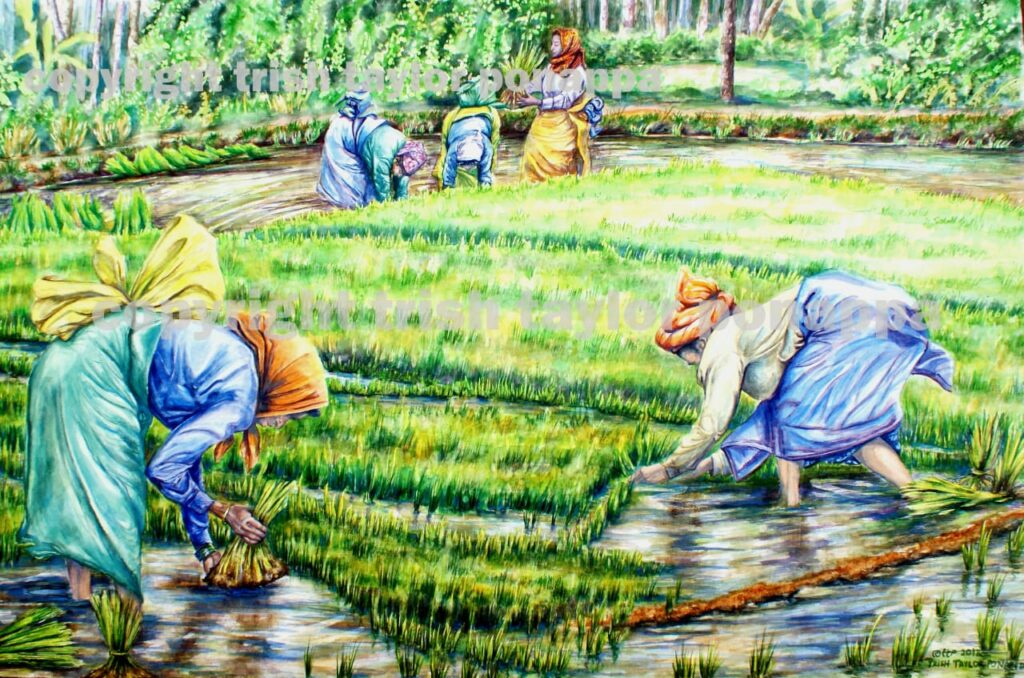
Jamma land tenure is unique to Kodagu (Coorg) district in Karnataka. Jamma lands consist of wetland for growing paddy, and the accompanying Baane land, initially used for cattle grazing and held free of assessment, now converted into coffee estates. It is estimated that the extent of ‘Jamma Baane’ land in Kodagu in the possession of the local people – Kodavas, Amma-Kodavas, Heggades, Airis, Koyavas, Moplas and Goudas – is around 2.55 lakh acres.
According to Sir J B Lyall, a British expert on tenures in Coorg who traced the origin of Jamma, it was originally a military tenure granted in consideration of military service and held on payment of half the assessment. Jamma was granted to the local inhabitants, largely by the Coorg Rajas (1600 AD to 1834 AD) and to a smaller extent by the British till 1895, under ‘sanads’ (title deeds).
For generations, the life of the local communities, centred around the cultivation of the Jamma lands, the principal tenure in Kodagu. The ownership was jointly held by the clan and it was managed by the head of the clan (Pattedara). Jamma lands could not be alienated as there was no provision for transferring the title of the property.
The issue involving the rights of the Jamma land-holders went before the Karnataka high court and a full bench of the court, in its judgement delivered in October 1993, held that Jamma Baane landholders had limited privileges for cattle grazing, supply of firewood and timber for domestic and agriculture purposes, but had no right to exploit the trees for commercial purposes, unless the holder had paid the full timber value to the government. The court also held that the land-owner had no right to the sub-soil.
The BJP government passed the Karnataka Land Revenue (Third Amendment) Act, 2011, to amend the Karnataka Land Revenue Act, 1964, to confer certain rights, including assessment of Baane land in Kodagu.
Prior to the Amendment, there was a ban on the sale of Jamma lands as the cultivator was only a ‘deemed owner’. The new legislation conferred the title of ‘occupant owner’ to the cultivator, and allowed the sale of land.
The legislation, it is feared, will legitimise large scale denudation of trees and the formation of human settlements on Jamma Baane lands as there will be a heavy influx of population from the neighbouring states. The presence of increased human habitation will have its impact on the adjoining forest land, its flora and fauna in Kodagu district, located in the fragile Western Ghats.
The Karnataka Land Revenue (Third Amendment), Act, 2011, received Presidential assent in 2013 after the bill was referred to the President by the Karnataka governor.
A writ petition was filed before the Karnataka High Court in 2013 which sought a stay on the operation of the Act until the disposal of the petition, and also sought to restrain the revenue department from mutating any Jamma land falling under Regulation 164 of the Coorg Land Revenue Regulation, 1899, in the name of the purchaser.
The petitioners urged the court to declare the Karnataka Land Revenue (Third Amendment) Act, 2011 ANNEXURE-A, as unconstitutional and void and direct the respondents and its officers not to enforce or give effect to the provisions of the Amendment. The High Court has admitted the petition.
The petitioners have also sought a direction to restrain the Karnataka government from compelling members of the joint families of the Kodava race to seek partition of their ancestral properties, including Jamma Baane lands, whether alienated or un-alienated, privileged or unprivileged. The petition has called for upholding the customary laws which stand abolished by the Amendment.
A section of people in Kodagu feel that in the interest of preserving the culture of Kodagu, and maintaining the ecological balance in the Western Ghats, the government should not give effect to the amendment.
With three consecutive years of unprecedented rains and landslides hitting Kodagu in 2018, 2019 and 2020, people are aware of the consequences of deforestation that could be triggered from/by the sale of Jamma lands.
KODAVAS EXEMPTED FROM FIREARMS LICENSE
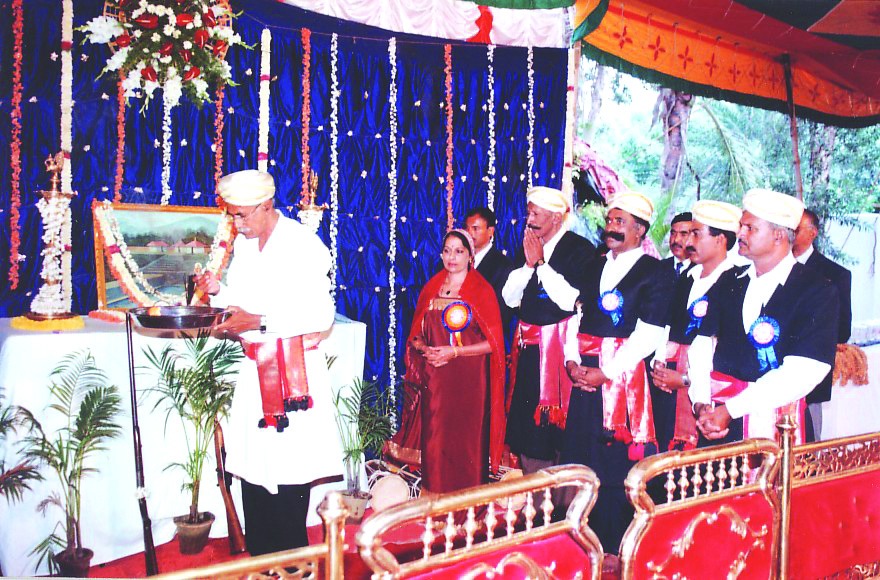
The Kodavas (Coorgs) living in Kodagu (Coorg) district of Karnataka are the only community in India who are exempted from obtaining arms licences.
The special privilege to own firearms without license was granted to the Coorgs by the British in recognition of their martial traditions. This was continued after independence by a notification issued by the Union government in 1963 which exempted “every person of (the) Coorg race and every jamma land tenure holder in Coorg” from the Indian Arms Act. There was no curb on the privilege even after Coorg, which was a separate state earlier, merged with Karnataka following the reorganisation of the states in 1956.
However, the exempted people have to obtain an exemption certificate from the district administration.
While granting exemption to the Kodavas in February 1861, the then
Chief Commissioner of Coorg, Mark Cubbon, said in the notification: “In consideration of the exalted honour and loyalty characteristic of this little nation of warriors and in recollection of its conspicuous services in aid of the British government, it is my pleasing duty to notify hereby for general information, in virtue of the power vested in me by the government of India that provisions of the Arms Act, commonly called Disarming Act, are not applicable to the gallant people of Coorg.”
The customs and traditions of the Kodavas are inseparably linked to arms. The birth of a son is announced to the world by firing a single gunshot in the air and a death in the family is made known by firing two shots in the air in rapid succession. People in the mountainous Kodagu district live in isolated homesteads surrounded by coffee estates and the only way to inform the neighbours is to fire gun shots.
Besides, guns are invariably used in all their important festivals. The Kodavas attach so much importance to weapons that one of their important festivals called Keil Poldu is solely devoted to the worship of arms. It was for these reasons that the Kodavas do not have licences for arms but are given exemption certificates.
A proposal to do away with the privilege under the Arms Act was made way back in 1964 by the Central government. But the move was dropped, apparently at the behest of Field Marshal K M Cariappa. The then Coorg Deputy Commissioner, Mr. T P Issar, in his report, had said : “It is a well-known fact that the gun, the odikathi (a small broad bladed sword) and the peechekathi (a type of dagger) are as much a part of the life of a Coorg as the kirpan is for the Sikhs and the kukri for the Gurkhas. From my study of the old gazetteers and other books on the life and culture of Coorg and from my knowledge of their present day customs, I am in a position to bear out the truth of the arguments of the Coorgs that these arms are inseparably linked with many of their ceremonial occasions.”
“These examples have been given here to impress the point that withdrawal of the exemption will amount to creating difficulties in the observance of many of their rites and customs.”
“It will be very pertinent to state here that in spite of the freedom enjoyed by the people of Coorg in the possession and use of arms, their behaviour as citizens has been generally exemplary”.
According to a government estimate, there are 19,641 firearms in the district, consisting of 14,534 under the exemption category and 5,107 under the licenced category.
In 1993, the Union government had sought the opinion of the Karnataka government on continuing the privilege granted by the British 132 years ago. This followed representation from the government of Andhra Pradesh to cancel the privilege as guns from Kodagu were reportedly reaching the hands of the outlawed People’s War Group (Maoists) in Andhra Pradesh.
The Karnataka government informed the Centre that there has been no misuse of the privilege. However, the state government pointed out that two arms dealers had allegedly indulged in gun-running, and the matter is under investigation by the Corps of Detectives.
A petition filed in the Karnataka High Court in 2015, which was revived subsequently in 2018, was filed by one Capt Chethan Y.K., who argued that the arms exemption amounted to discrimination on the basis of caste.
The matter came up before a Division Bench comprising Chief Justice Abhay Shreeniwas Oka and Justice Mohammad Nawaz. During the hearing, the Union government represented by the assistant solicitor general of India C. Shashikantha stated that the exemption granted since 1963 to certain class of people in Kodagu from obtaining a licence to possess and carry firearms under the provisions of the Arms Act, 1959, was being reviewed along with the review of the entire Arms Act.
The assistant solicitor general of India informed the Bench that the home ministry had constituted a committee to review and suggest amendments to the Arms Act, and the process had been initiated to secure the views of stakeholders.
Through a gazette notification in October, 2019, The Union home ministry extended the special provision that exempts the community from getting a gun licence till October 31, 2029. This applies to any person who is ‘Coorg by race’ and all Jamma land holders in Kodagu.
The notification stated: “The arms or ammunition carried or possessed by any person being Coorg by race and every Jamma tenure holder in Coorg and herein exempted whilst residing or travelling outside the district of Coorg shall not exceed one rifle with 100 rounds of ammunition for the same and one smooth bore breech or muzzle loading gun with 500 cartridges or the equivalent in leaden shot and gunpowder.”
By continuing the exemption given to Kodavas (Coorgs) in Karnataka, the Union government has recognised the centrality of arms worship in the religious and cultural practices of the Kodavas.
Though the privilege has been enjoyed by the Coorgs for more than 150 years since the times of the British, what prompted the Union government to continue the privilege was the fact that guns were seldom misused by the community in crimes or anti-national activities.
It is a well-known fact that Kodagu is a nursery of the Indian Army and the district has contributed a sizable number of locals to the defence services.
